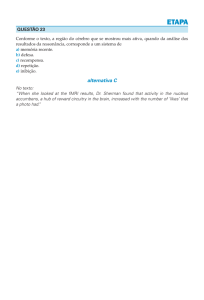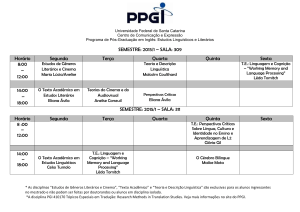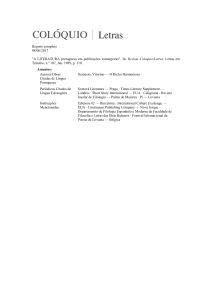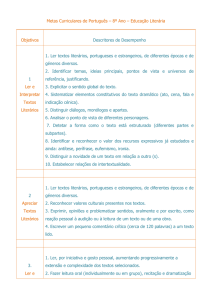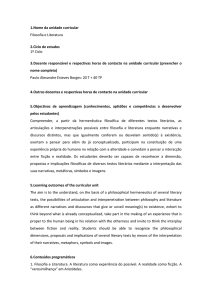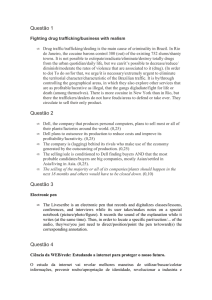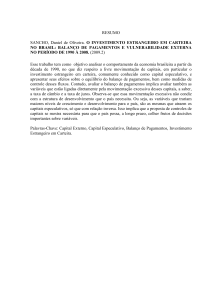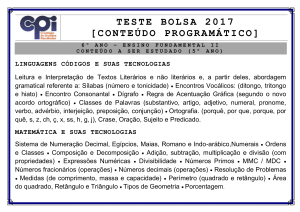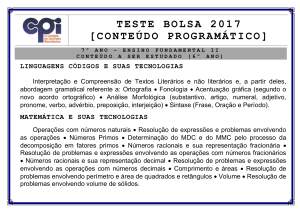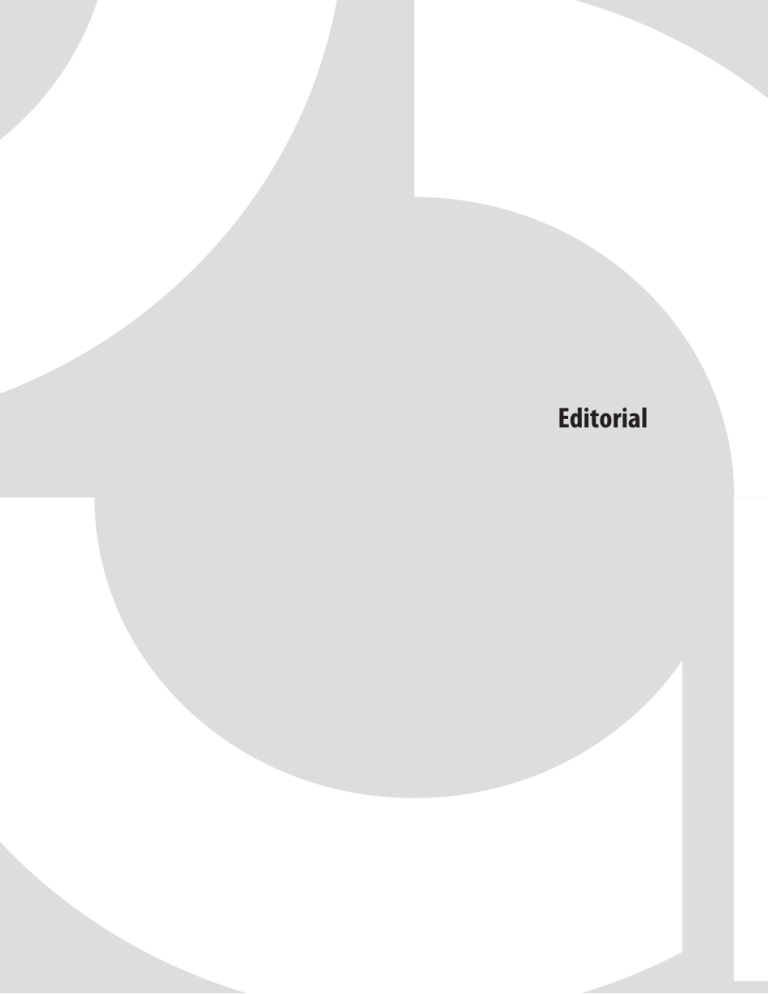
Editorial
Editorial
“As formas híbridas, com sua dupla inscrição, parecemme constituir o território mais extenso da literatura.”
(Luís Costa Lima: 2006, 352)
“Em termos históricos e de gênero, tanto o romance
quanto o filme têm consistentemente canibalizado
gêneros e mídias antecedentes” (Robert Stam, 2008)
Atualmente, estudos teóricos, críticos literários, autores, pesquisadores têm
questionado os limites dos estudos literários, partindo de uma questão que
se impõe quando nos vemos imersos em uma sociedade adjetivada de globalizada, espetacular, midiática e pautada pela rapidez no trânsito de ideias,
de informações e de imagens: há limites para os estudos literários? Esse
questionamento se desdobra em outros se considerarmos, por um lado,
que há limites - quais são? quem os determina? - e , por outro, se eles não
existem, dúvidas e preocupações se presentificam - sem limites, os estudos
literários se descaracterizam?
Além do contexto atual notadamente marcado por imagens, experimentalismos, fragmentações; a proliferação de práticas analíticas e a diversidade de teorias são também motivadoras de reflexões em torno dos limites e
das possíveis e pertinentes interseções entre os estudos literários e as outras áreas do conhecimento. Quando se discutem os limites, há de considerar a flexibilidade e a singularidade dos estudos literários; singularidade
que pode ser contestada se considerarmos que o hibridismo e pluralidade
caracterizam o texto literário.
É preciso salientar que o tema da Revista da Anpoll 30, Estudos literários:
limites e intersecções, evidencia que não há um, mas possíveis limites e interseções e considerando, portanto, essas possibilidades, reunimos, neste número, artigos que transitam entre literatura, filosofia, religião, cinema, música, sociologia etc.
O primeiro artigo, de Ângela Maria Rubel Fanini, discute a interseção
entre Literatura e Filosofia e, a partir dela, analisa o conto “O alienista”, de
Machado de Assis, à luz da reflexão de Martin Heidegger. Em seguida, de
uma perspectiva bakhtiniana, temos o mapeamento de diferentes questões
suscitadas pela aproximação entre literatura e Morte no artigo Tanografias
e decomposições: o discurso da morte na literatura, de Augusto Rodrigues
Júnior.
No terceiro artigo, Estudos culturais e a crítica literária, Carlos Magno
Gomes discute a importância dos estudos culturais como intersecção entre
forma e conteúdo do texto literário.
Em Ociente: Terra do Poente – considerações sobe Filosofia e Literatura,
Cícelo Cunha Bezerra expõe, a partir da crítica de Heidegger à metafísica, alguns elementos que contribuem para o estabelecimento de um espaço
“aberto” no qual filosofia e literatura dialogam.
Na sequência, Cleide Maria de Oliveira, no artigo Poesia e Epifania,
analisa a poesia de Adélia Prado, centrando sua abordagem na religiosidade
mística que permeia o obra da poeta e João Manuel dos Santos Cunha, em
Afinidades poéticas: a vontade de cinema na literatura, o desejo de literatura
no cinema, examina a transmutação do poema “O padre e a moça” (1962) de
Carlos Drummond de Andrade para o cinema (1965), realizada por Joaquim
Pedro de Andrade, com o intuito de comprovar a permanência na versão
fílmica.
Em Os sertões e Facundo: Duplos, Josalba Fabiana dos Santos compara as
obras de Euclides da Cunha e de Domingo F. Sarmiento, apoiando-se nas teorias de Gilles Deleuze pra pensar a identidade e a alteridade entre os textos.
A partir de uma reflexão em torno do espaço urbano, Maria Cleci
Venturini e Nincia Cecília Riba Borges Texeira analisam o texto “A Bahia
que Caetano e Gil não cantaram”, inserido no livro Literatura Marginal,
organizado por Férrez e embasam o estudo numa perspectiva discursivaliterária , com o objetivo de aliar o que é da ordem real e o ficcional.
Em Pesquisa, interseções e produção do conhecimento em Literatura
Comparada hoje, Paulo Sérgio Nolasco dos Santos propõe uma discussão
teórica-crítica dos estudos literários, enfatizando o comparatismo contemporâneo e analisa o texto/conto “Alice no País do Esquecimento”, do
escritor Lauro José da Cunha.
Ao analisar chistes joyceanos sobre o nome de Sigmund Freud, Piero
Eyben, em Joy, C’est Freud(E)!, desvela como Joyce propõe uma escritura metafórica-literária da interpretação psicanalítica em Finnegans Wake.
Com o objetivo de contribuir para a discussão do conceito de cultura popular, Rogério Lima apresenta uma reflexão sobre o processo de espetacularização em várias esferas da vida sócia a partir da análise de crônicas de
Bilac, João do Rio e Manuel Bandeira e das canções do RAPPA e do grupo
carioca F.UR.TO.
A fim de demonstrar como o texto literário constitui um espaço onde a
relação dialética entre memória e esquecimento se entrelaça à questão da
identidade cultural do imigrante, Shirley de Souza Gomes Carreira analisa
o conto “Unaccustomed earth”, de Jhumpa Lahiri.
Encerra este número, o artigo A escrita epistolar, a literatura e os jornais
do século XIX: uma História em que Socorro de Fátima Pacífico Barbosa,
apropria-se anacronicamente dos objetos escritos no passado, para analisar a carta, gênero epistolar, como objeto literário e enfatizar que a leitura
de jornais e de periódicos como forma de educação e de formação de práticas de escrita.
Nos limites alcançados e/ou satisfatoriamente extrapolados e nas intersecções estabelecidas, os artigos aqui reunidos corroboram para a reflexão
sobre o tema deste número e são, portanto, um convite a uma instigante
leitura.
André Luís Gomes
Editor-Chefe da Revista da ANPOLL
Editorial
It seems to me that the hybrid forms with double
inscription build a wider territory related to literature
(Luís Costa Lima: 2006, 352)
“In terms of history and genre, the romance and the film
have consistently cannibalized anticipated genres and
Medias” (Robert Stam, 2008)
Recently, theories and studies, literary critics, authors, researchers have
questioned the literary study limits of literary studies, coming from a
question that imposes itself when we see ourselves being part of a society
classified as globalized, spectacular, technological and based on the fast
transmission of ideas, information and images: Is there a limit to the
literary studies?
This questioning leads to others if we consider, on one hand, that there
is a limit – and if there is, what are they? – Who tells which ones they are? –
And, on the other hand, if they exist, doubts and concerns are there within
them – If there are no limits, the literary studies lose their characteristics?
Besides this recent context highlighted by images, experiments, fragments;
the proliferation of analytical practices and the diversities of theories are also
motivating and leads to reflections about limits in literature as well as possible
and pertinent intersections between literature and other knowledge areas.
When we talk about limits, we have to consider the flexibility and
singularity of literary studies, singularity that can be denied if we consider
a literary text is characterized by the hybridism and the plurality.
It is necessary to highlight that Anpoll Magazine number 30 theme
is Estudos literários: limites e intersecções, (Literary Studies: limits and
intersection), the aim is to show that there is not only one possibility, but
possibilities in literature, so we reunited in this issue articles about literature,
philosophy, religion, cinema, music, sociology, etc.
The first article, by Ângela Maria Rubel Fanini, talks about the intersection
between literature and philosophy and, analyses the tale “O alienista”, by
Machado de Assis, bringing the reflection upon the thoughts of Martin
Heidegger. The next article, in Bakhtin’s perspective, we present different
questions between Literature and Death in Tanografias e decomposições: o
discurso da morte na literatura, by Augusto Rodrigues Junior.
In the third article, Estudos culturais e a crítica literária, Carlos Magno
Gomes writes about the importance of cultural studies as an intersection
between form and content of the literary text.
In Ociente: Terra do poente- considerações sobre Filosofia e Literatura,
Cícero Cunha Bezerra explains, relating it to Heidegger’s metaphysics critic,
some elements that contribute to the creation of an open space in which
philosophy and literature talk.
Cleide Maria de Oliveira, in the article, Poesia e Epifania, analyses
Adélia Prado’s poem, focusing her approach in the mystic religiosity that
we can find in her poems. João Manuel dos Santos Cunha’s masterpiece, in
Afinidades poéticas: a vontade de cinema na literatura, o desejo de literatura
no cinema, examines the transmutation of the poem “O padre e a moça”
(1962) by Carlos Drummond de Andrade to the cinema (1965), written
by Joaquim Pedro de Andrade, that aims to prove that the poetic ideas still
remain in the film production.
In Os Sertões e Facundo: Duplos, Josalba Fabiana dos Santos compares
Euclides da Cunha and Domingo F. Sarmiento’s masterpieces, using Gilles
Deleuze’s theories to help them think of the identity between the texts.
From a reflection that surrounds the urban space, Maria Cleci Venturini e
Nincia Cecília Riba Borges Teixeira analyse the text A Bahia que Caetano e Gil
não cantaram that is in the book Literatura Marginal, organized by Férrez and
use a literary-discourse perspective, aiming at joining the realism and fiction.
In Pesquisa, intersecções e produção do conhecimento em literatura
comparada hoje, Paulo Sérgio Nolasco dos Santos writes about a critic
discussion, emphasizing the contemporary comparativeness and analysis the
text/tale “Alice no país do Esquecimento”, by Lauro José da Cunha.
By analyzing Joyce in Sigmund Freud’s name, Piero Eyben, in Joy,
C’est Freud (E)!, comes to the conclusion that Joyce talks about a literary
metaphoric scripture of a psychoanalytical interpretation in Finnegans Wake.
With the aim of contributing in the understanding of the concept of
popular culture, Rogério Lima presents a reflection about the process of
turning a literary text in a drama production in various aspects of social life
from the analyses of Bilac, João and Manuel Bandeira’s chronicles and of
Rappa’s songs and also from the Carioca group F.U.R.TO.
To demonstrate how the literary text constitutes a space where dialectic
relation between memory and oblivion is intrinsic related to the immigrant
identity culture, Shirley de Souza Gomes Carreira analyses the tale
“Unaccustomed earth, by Jhumpa Lahiri.
The last article of this magazine is A Escrita Epistolar, a literatura e os
jornais do século XIX: uma História, in which Socorro de Fátima Pacífico
Barbosa takes to herself the objects used in the past, to analyse the letter, as
a literary object related to the formation of writing practice.
In the limits reached and/or satisfactorily extrapolated and in the
established intersections, the presented articles and the epigraphs that open
this editorial help the reflection about this issue and they are an invitation
to an interesting reading.
Andr é Luís Gomes
Organizer
Eneida Nalini de Oliveira
Translation

